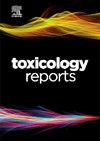秀丽隐杆线虫的发育和活动测试(wDAT)可用于区分可逆和不可逆的发育效应
Q1 Environmental Science
引用次数: 0
摘要
发育迟缓和自发运动活动的改变,以及这些不良反应的可逆性是用于化学品安全性评价的主要终点。使用5-氟尿嘧啶(5FU)、羟基脲(HU)或利巴韦林(RV)在秀丽隐杆线虫中的亚致死浓度对这些终点进行了评估,这些致畸物与哺乳动物胎儿生长降低有关。秀丽隐杆线虫由卵发育为产卵成虫约需三天。同步队列要么连续暴露,要么从孵化后第一次喂食开始暴露24 h(仅早期)。在两种暴露方案中,所有三种化学物质的发育迟缓都是剂量反应性的。对于5FU和HU,持续暴露组和早期暴露组的发育迟缓和低活动水平相似,与不可逆的发育影响一致。在发育中的秀丽隐杆线虫中观察到的低活性可能与报道的5fu诱导的肌肉损伤和hu诱导的暴露后对哺乳动物运动参数的影响有关。与5FU-和hu诱导的低活动性相反,RV在两种暴露方案中都与轻度多动的非显著趋势相关。随着暴露时间的延长,连续的RV暴露会导致顺序发育里程碑的延迟。在早期暴露组中,RV诱导的延迟显著减少,但并未消除,这与RV对发育进展的累积影响一致。这些发现表明秀丽隐杆线虫可能是检测对生物体发育具有不可逆、可逆和/或累积效应的化学物质的有用模型。本文章由计算机程序翻译,如有差异,请以英文原文为准。
The Caenorhabditis elegans worm Development and Activity Test (wDAT) can be used to differentiate between reversible and irreversible developmental effects
Developmental delay and spontaneous locomotor activity changes, as well as the reversibility of these adverse effects are apical endpoints used in chemical safety evaluations. These endpoints were assessed at sublethal concentrations in C. elegans using 5-fluorouracil (5FU), hydroxyurea (HU), or ribavirin (RV), teratogens that are associated with reduced fetal growth in mammals. C. elegans develop from egg to egg-laying adult in about three days. Synchronized cohorts were exposed either continuously, or for 24 h (early-only) from first-feeding after hatching. Developmental delays were dose-responsive for all three chemicals in both exposure schemes. For 5FU and HU, developmental delays and hypoactivity levels were similar in continuous and early-only exposure groups, consistent with irreversible developmental effects. The observed hypoactivity in developing C. elegans may be related to reported 5FU-induced muscle impairment and HU-induced post-exposure effects on locomotion parameters in mammals. In contrast to 5FU- and HU-induced hypoactivity, RV was associated with a non-significant trend to slight hyperactivity in both exposure schemes. Continuous RV exposures induced delays to sequential developmental milestones that increased with exposure duration. RV-induced delays were significantly reduced but not eliminated in early-only exposure cohorts, consistent with cumulative RV effects on developmental progress. These findings suggest that C. elegans may be a useful model for detecting chemicals with irreversible, reversible, and/or cumulative effects on organismal development.
求助全文
通过发布文献求助,成功后即可免费获取论文全文。
去求助
来源期刊

Toxicology Reports
Environmental Science-Health, Toxicology and Mutagenesis
CiteScore
7.60
自引率
0.00%
发文量
228
审稿时长
11 weeks
 求助内容:
求助内容: 应助结果提醒方式:
应助结果提醒方式:


